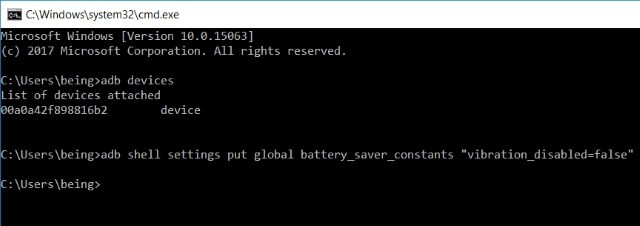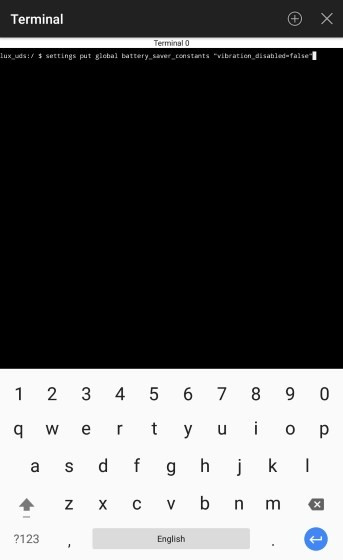How to customize battery saving mode on Android Oreo
Recently, Android Oreo has beenofficiallyreleased and is still freeof new featuresandoptimizations.This versionis considered to be one ofthe mostfamiliarversions ofthe developer forAndroid, with manyoptionsdepending on your choice only.forusers who use the softwarea ADB.In the article, you will be guided on how to customize the battery saving mode on Android Oreo.
As everyone knows, the battery saving mode on Android devices is a very useful feature, basically limiting or "killing" all background processes to ensure prolonged battery life.This mode also disables the effect, the device's vibration mode, and also dims the brightness of the screen.Fortunately, Android Oreo allows users to customize these features.So, if you feel uncomfortable because losing these functions while using the battery at a low level, read on, the article will show you the battery saving mode (Battery Saver) in Android Oreo easily. .
Customize battery saving mode in Android Oreo using ADB
Note: The following method requires Minimal ADB driver and Fastboot to be installed on your computer.If not, you can download and install them from here.
To get started, go toSettings> System> Developer Options and turn on the 'USB Debugging' feature.

Now, connect your device to the computer and launch the ADB shell.When in there, type the following commands:
To enable or disable vibration mode:
adb shell settings put global battery_saver_constants "vibration_disabled = true / false"
To activate and disable animation:
adb shell settings put global battery_saver_constants "animation_disabled = true / false"
To enable and disable screen dimmer mode:
adb shell settings put global battery_saver_constants "adjust_brightness_disabled = true / false"
For example, use the following command to activate vibrate mode on Android Oreo device:
adb shell settings put global battery_saver_constants "vibration_disabled = false"

Alternatively, you can choose to combine different commands and execute them all at once, simply by separating them with commas.For example, turning on animation, dimming screen brightness and turning on vibrate mode will use the following command:
adb shell settings put global battery_saver_constants "animation_disabled = false, adjust_brightness_disabled = true, vibration_disabled = false"

Note: Any value you do not change will return to the original default value.
Customize the battery saving mode of Android Oreo with Root
Also, if the device has been rooted with Magisk or SuperSU, you can run these commands from the phone.To do so, simply download a command-line emulator application like Terminal Emulator for Android or Termux and simply execute the commands you want as above.
- Instructions for rooting Android phones with Magisk
Note: While executing commands from the phone, be sure to ignore " adb shell" from the commands, for example, if you have enabled vibration mode, the command will be as follows:
settings put global battery_saver_constants "vibration_disabled = false"

Control battery saving mode with Battery Saver Mode of Android Oreo
Google's Android Oreo is growing to become one of the most developer-friendly Android versions.With so many features available to the developer community, the level of customization provided by Android Oreo is definitely high.Thus, the ability to customize Battery Saver Mode on Android Oreo 8.0 is a handy feature for users.
You should read it
- How to turn off battery saving mode on Android, Samsung, Xiaomi phones
- 11 tips for maximum battery saving for your phone
- How to enable battery saving mode on Opera
- Instructions to enable / disable Windows 10 Battery Saver (Battery Saver) feature
- The way Android P increases battery life
- Steps to enable battery saving mode (Battery Saver) on Windows 11
- Use Low Power Mode to save battery on iOS
- Google confirms the dark mode on Android will save more battery
May be interested
- Google released Android Oreo Go for low-profile smartphones
 the first oreo go phones will be available early next year.
the first oreo go phones will be available early next year. - Google confirms the dark mode on Android will save more battery
 google has confirmed that the new dark mode launched on android 9.0 pie can help android smartphones save more battery power.
google has confirmed that the new dark mode launched on android 9.0 pie can help android smartphones save more battery power. - Install Android Oreo now
 the latest version of the android operating system has been revealed. however, at present, only a few devices receive the update soon, the rest will have to wait a while longer. if you are using devices like nexus or pixel, you can put the oreo version on your phone right away without unlocking the boot program (bootloader) or doing something complicated.
the latest version of the android operating system has been revealed. however, at present, only a few devices receive the update soon, the rest will have to wait a while longer. if you are using devices like nexus or pixel, you can put the oreo version on your phone right away without unlocking the boot program (bootloader) or doing something complicated. - Instructions to enable battery saving mode on Windows 11
 by default, battery saver mode automatically turns on when your computer has 20% or less battery life and automatically turns off when your computer is connected to a power source. however, you can turn it on whenever you want, especially in situations where you can't plug in for a long period of time.
by default, battery saver mode automatically turns on when your computer has 20% or less battery life and automatically turns off when your computer is connected to a power source. however, you can turn it on whenever you want, especially in situations where you can't plug in for a long period of time. - 11 tips for maximum battery saving for your phone
 in order to save battery power, you need to be aware of very small details, especially when there is not much battery left but you still have important things to use the phone.
in order to save battery power, you need to be aware of very small details, especially when there is not much battery left but you still have important things to use the phone. - Tips to increase battery life for iPhone 5
 in order for the iphone 5 to have a longer battery life, you can turn off some unnecessary utilities, change the screen brightness, iphone lock mode or install support applications.
in order for the iphone 5 to have a longer battery life, you can turn off some unnecessary utilities, change the screen brightness, iphone lock mode or install support applications. - How to turn off automatically add the application icon to the Home screen Android Oreo
 when downloading the application on android will appear to add an application icon to the main screen. on android oreo, users can turn off automatically adding applications to the android oreo screen.
when downloading the application on android will appear to add an application icon to the main screen. on android oreo, users can turn off automatically adding applications to the android oreo screen. - The way Android P increases battery life
 google has introduced significant new features to improve battery life on android in the past few years. with oreo, the company has brought the best improvements ever and this is how it is looking to improve battery life even further with android p.
google has introduced significant new features to improve battery life on android in the past few years. with oreo, the company has brought the best improvements ever and this is how it is looking to improve battery life even further with android p. - How to bring Android 8.0 Oreo to old phones
 users can still use android oreo version on their old android device by installing oo launcher for android oreo.
users can still use android oreo version on their old android device by installing oo launcher for android oreo. - The most notable new feature of Android 8.0 Oreo
 the latest android version has many small but important additions, all of which make this operating system stand out and more mature than ever.
the latest android version has many small but important additions, all of which make this operating system stand out and more mature than ever.









 5 ways to take screenshots on Galaxy Note 8
5 ways to take screenshots on Galaxy Note 8 How to install Linux on Android doesn't need root
How to install Linux on Android doesn't need root How to use NEV Privacy - Hide Pictures hide photos, apps on Android
How to use NEV Privacy - Hide Pictures hide photos, apps on Android How to use the Live Messages feature on Samsung Galaxy Note 8
How to use the Live Messages feature on Samsung Galaxy Note 8 How to fix 'Screen overlay detected' error on Android device
How to fix 'Screen overlay detected' error on Android device How to open multitasking multitasking mode on Android phones
How to open multitasking multitasking mode on Android phones